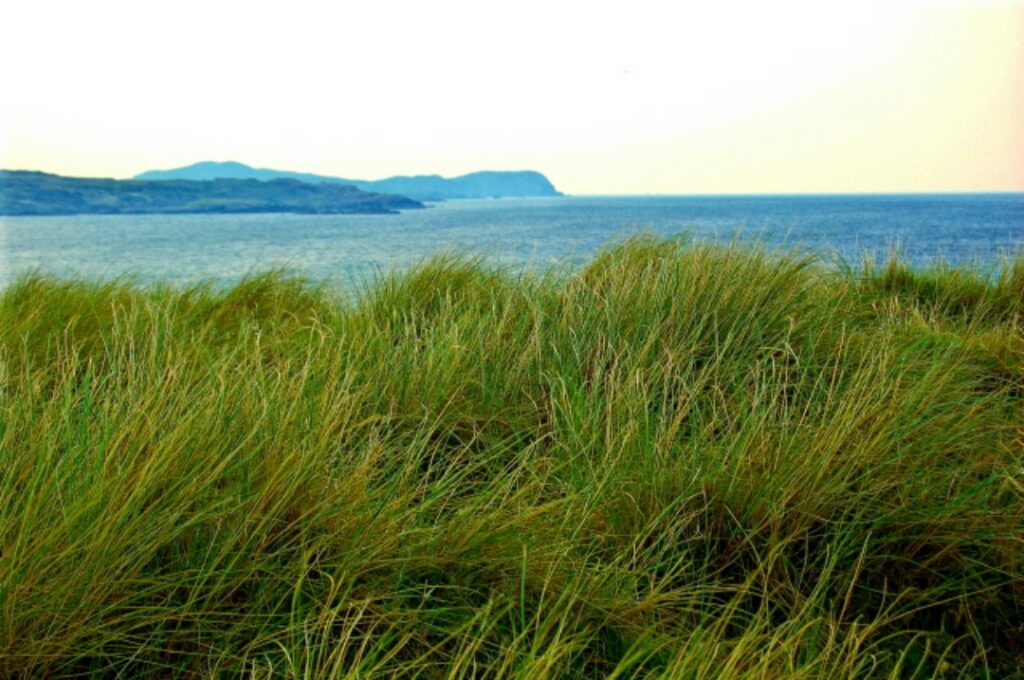
Joseph Mischyshyn, CC BY-SA 2.0
United Kingdom
Grasses
Ammophila arenaria

Joseph Mischyshyn, CC BY-SA 2.0
General Description / Cultural Significance
The English, Welsh, Scottish, and Northern Irish have very diverse cultures but there is much that they share. “The Scots might favor heather; the English roses; the Northern Irish the smell of newly mown grass and the Welsh the fresh smell of daffodils.” However, with that said, the salty air, coming off the sea and through the grasses deeply connects with most people of the United Kingdom. They are all also historically seafaring people and most of them have ancestors who are mixtures of all four nationalities. The people of all four countries of the United Kingdom have strong relationships with the windswept coasts common to their countries and seagrass is an important part of their natural heritage. These areas share similar natural vegetation of grasses that rapidly propagate to protect the coasts. Their underground and underwater fibrous cord-like root systems transverse the countries and protect them. They are hardy and thrive in the salt sprays and howling gales, and the sheaths and blades store water.
The intertidal areas of the UK are inhabited by Eel and Seagrasses. The beach dunes have Marram Grasses, Sand Sedge, and many more. The rocky cliffs and estuaries also have more grasses, rushes, and sedges. Marram Grass (Ammophila arenaria) can be found on the first line of dunes that line most of the coast of the United Kingdom. This native plant is tussocky, spikey, and coarse and appears in dense clusters of green and gray. These grasses are widely known examples of xerophytes and are well adapted to survive the challenging conditions of the coastal regions it inhabit. The grass has highly developed underground systems of stems and roots known as rhizomes that anchor the grass deep into the sand, making it resistant to winds.
All four countries were once mostly rolling lands of grasses, so the scent of grasses, carried in the sea air is the significant and unifying aroma to all four countries—the United Kingdom as a whole.
Climate Change / Conservation Status
The United Kingdom had shared a Temperate Maritime Climate characterized by the absence of extreme weather, but that has changed, and the UK has become affected by climate change in a combination of intense weather, torrential rains, massive flooding, erosion, rising temperatures, and warming, rising seas.
Marram grass is well adapted to survive extreme weather conditions on the coast of the UK because of its extensive root systems and glossy rolled-up leaves that protect it from drying out. However, with rising sea levels, it is threatened by an eventual loss of habitat. Furthermore, it is an invasive species and therefore can reduce species diversity and prevent the growth of indigenous arthropods on the coast.
Northern Ireland’s biodiversity and cultural heritage lie primarily in its coastal and terrestrial freshwater habitats, which support 20,000 species, and the country’s fishing, tourism, and renewable energy. Flooded grasslands and other wetlands form 7% of Northern Ireland’s geological areas. Climate change increasingly degrades the natural environment requiring increased conservation, particularly to salinity risks. Damage to marine ecosystems is evident, and a loss of cold-water species is noticeable.
Scotland’s rivers and lochs contain 90% of the UK’s surface freshwater, and rising sea levels impact freshwater and marine ecosystems. In 2017, the annual rainfall had increased by 13% above earlier decades of the 20th century. Land temperature is also rising.
In Wales, the rainfall, flooding, and higher average sea levels are greater than in the low coastal areas. There are warmer average temperatures and hotter summers across Wales.
The meadows of seagrass plants spread across the UK are a natural solution to the climate crisis because they have the potential to sequester and store huge amounts of carbon dissolved in the ocean, known as ‘blue carbon’. Seagrass shelters and supports wildlife biodiversity and captures carbon at a rate 35 times faster than tropical rainforests. However, scientific research published in 2021 revealed a vast range of seagrass losses. Efforts to restore seagrass and the ecosystem services they provide are underway.
Alternate Names
Beachgrass
Bent Grass
Sources
Adapting to climate change: Progress in Wales, September 2023, https://www.theccc.org.uk/wp-content/uploads/2023/08/Adapting-to-Climate-Change-Progress-in-Wales.pdf
Climate change: how it affects Britain. (2004). Greenpeace., from https://www.greenpeace.org.uk/what-we-do/climate/climate-change-how-it-affects-britain/
Green, Alix E. et al. 2021. Historical Analysis Exposes Catastrophic Seagrass Loss for the United Kingdomhttps://www.frontiersin.org/articles/10.3389/fpls.2021.629962/full
UK Climate Change Risk Assessment Evidence Report – Summary for England”. (2017). Committee on Climate Change. pp. 11.
UK Climate Change Risk Assessment Evidence Report – Summary for Northern Ireland”. (2017). Committee on Climate Change.
UK Climate Change Risk Assessment Evidence Report – Summary for Scotland”. (2017). Committee on Climate Change.
UK Climate Change Risk Assessment Evidence Report – Summary for Wales”. (2017). Committee on Climate Change.
The Wildlife Trusts: https://www.wildlifetrusts.org/habitats/marine/seagrass#:~:text=There%20are%20four%20species%20of,species%2C%20commonly%20known%20as%20eelgrass.

